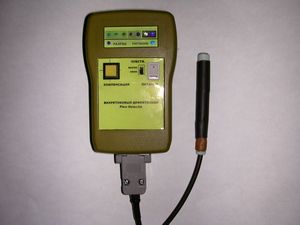Main Sector of relevance\IRC classification 8. Industrial Manufacturing, Material and Transport Technologies
8.92 Portable vortex-current flaw detector FD

Developers’ contact information
State Scientific Institution “The Institute of Applied Physics of the National Academy of Sciences of Belarus”
16 Akademicheskaya Street, Minsk BY-220072
Summary
Portable vortex-current flaw detector with overhead pencil-type converter, designed to detect surface defects in ferromagnetic items such as cracks.
Description
Scope of application
The device is designed to detect defects such as of cracks located on the
surface of ferromagnetic (steel, cast iron) products. It allows you to detect
defects at low levels of controlled surface purity, and under a coating (paint,
plaster, etc.) with a thickness up to 1 mm, in the presence of various
contaminants (grease, sawdust). Distinctive features include high sensitivity
and reliability of defects detection, ease of use.
Operation
The operation of the unit is based on the vortex-current method: vortex
electric currents are generated in the surface layer of the controlled items;
existence of a defect is determined through the analysis of parameters of a
secondary electromagnetic field that they have created.
Construction
The device consists of an electronic unit and a connected pencil-type
converter. The control is carried out during the process of displacement of the
converter on the control surface. The existence of a defect is determined by an
external LED scale and is duplicated by the sound signal. Safe to work with,
shock-resistant casing. Converters have a wear-resistant work surface.
Specifications
Minimum size of defects found with surface purity Rz of not more than 5:
Technology type
Technical advantages and economic benefits
High defects detection reliability, ease of use.
Technology differentiation and uniqueness
A new way of processing information has been implemented, which allows to significantly reduce the influence of various factors hindering the results of monitoring.
Context in which technology was identified
The device is implemented at Minsk Motor Plant, in the locomotive depot in Lida.
Technological keywords
Flaw detector, vortex-current control.
Development Stage
Intellectual property rights
Range of applications
Industrial enterprises.
Classifier Used at the EU Innovation Relay Centres
Preferable Regions
Practical experience
The device operates in the industry.
Environmental impact
None.
Type of collaboration sought
Terms and restrictions
On a contractual basis.
Available technical assistance